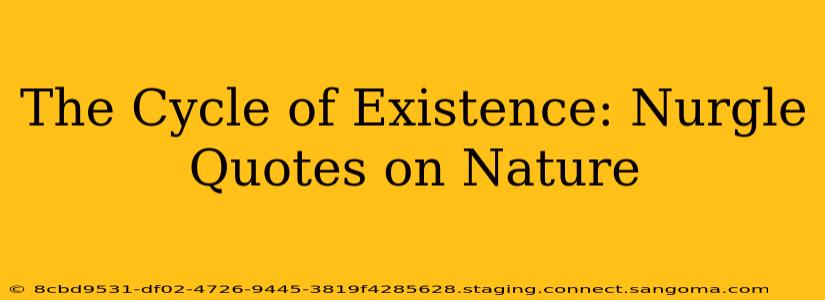Nurgle, the Chaos God of disease and decay in the Warhammer 40,000 universe, is often misunderstood. While he's depicted as a bringer of pestilence and rot, his philosophy, albeit twisted, offers a unique perspective on the natural world and the cycle of life and death. This exploration delves into Nurgle's warped worldview, examining his pronouncements on nature and the intricate role he plays within it. We'll unpack his perspective, examining his apparent contradictions and revealing the complex, albeit horrifying, beauty of his vision.
What Does Nurgle Represent in Warhammer 40k?
Before diving into Nurgle's quotes on nature (which, admittedly, are few and far between in the traditional sense, requiring interpretation of his actions and the actions of his followers), understanding his core tenets is crucial. Nurgle isn't simply a destructive force; he embodies the inevitable cycle of decay and renewal. His domain is not one of sterile nothingness but a vibrant, albeit grotesque, ecosystem teeming with life—even if that life is fleeting and often parasitic. He sees the beauty in the process of decomposition, the transformation from one form to another, the constant flux of existence. He isn't about annihilation; he's about transformation.
Nurgle's "Quotes" on the Cycle of Life and Death: An Interpretation
While Nurgle doesn't offer eloquent pronouncements like a philosophical sage, his actions and the beliefs of his followers speak volumes. We can infer his perspective on nature from these observations:
Does Nurgle believe in the beauty of decay?
Yes, in a very specific, Nurgle-esque way. The beauty he perceives is not the pristine beauty of an untouched forest, but the vibrant, teeming life that emerges from decay. The festering sores, the bubbling boils, the rampant growth of fungi – these are all manifestations of life, albeit twisted and grotesque, flourishing in the wake of death. For Nurgle, the beauty lies in the relentless cycle, the constant churn of creation and destruction, a chaotic symphony of existence.
What is Nurgle's view on life and death?
Nurgle sees life and death not as opposing forces but as two sides of the same coin, inextricably linked in an eternal dance. Death is not an end but a transition, a necessary component in the perpetual cycle of renewal. Every death fuels new life, a macabre fertilization process that Nurgle embraces wholeheartedly.
How does Nurgle see the interconnectedness of nature?
Nurgle's perspective highlights the deep interconnectedness of all things in nature. Everything is connected, everything decays, and everything is reborn in a new form. The rotting corpse nourishes the earth, which in turn sustains new life. This interconnectedness, however disturbing, is a fundamental aspect of his worldview.
The Paradox of Nurgle's Nature
The paradox of Nurgle lies in his celebration of decay and disease. While seemingly destructive, his influence, from a certain perspective, contributes to the balance of nature. He represents the often-overlooked aspects of the natural world: decomposition, the recycling of nutrients, the constant flux between life and death. He is, in his own twisted way, a force of renewal.
Conclusion: Understanding the Grandfather
Nurgle's perspective on nature offers a challenging, unsettling, yet ultimately fascinating lens through which to view the natural world. By understanding his twisted philosophy, we gain a deeper appreciation for the complexities of the cycle of life and death and the interconnectedness of all things, even in the most horrifyingly beautiful of contexts. His domain is not one of annihilation, but of relentless, chaotic transformation – a grotesque and morbid waltz of existence.

